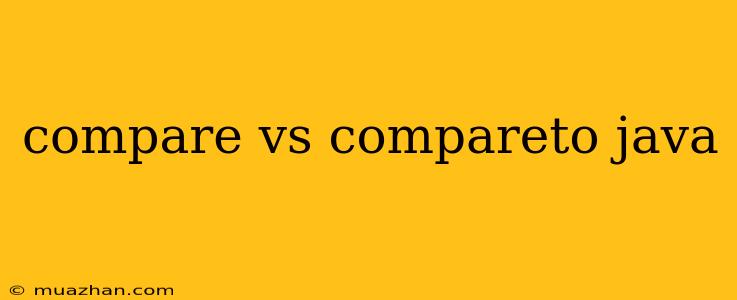Compare vs CompareTo in Java: Understanding the Differences
Both compare() and compareTo() are methods used for comparing objects in Java, but they serve slightly different purposes and are used in different contexts.
The compare() Method:
-
Purpose: The
compare()method is a static method found in thejava.util.Comparatorinterface. It is primarily used for comparing two objects of the same type and returning an integer value that indicates their relative order. -
Signature:
public int compare(T o1, T o2);
-
Return Values:
- Negative:
o1comes beforeo2. - Zero:
o1is equal too2. - Positive:
o1comes aftero2.
- Negative:
-
Usage: The
compare()method is typically used in conjunction with sorting algorithms likeCollections.sort()orArrays.sort(). It provides a custom comparison logic for sorting elements in a specific order.
The compareTo() Method:
-
Purpose: The
compareTo()method is a non-static method that is usually implemented by classes that need to be compared, such as theString,Integer, andDoubleclasses. It is used to compare an object with another object of the same type. -
Signature:
public int compareTo(Object o);
-
Return Values: The return values are similar to the
compare()method:- Negative: The current object comes before the other object.
- Zero: The current object is equal to the other object.
- Positive: The current object comes after the other object.
-
Usage: The
compareTo()method is commonly used for:- Sorting: Implementing the
Comparableinterface allows objects to be sorted directly using methods likeCollections.sort(). - Comparison: Directly comparing two objects of the same type.
- Sorting: Implementing the
Key Differences:
- Static vs. Non-static:
compare()is static, whilecompareTo()is non-static. - Usage:
compare()is used for generic comparison of two objects, whilecompareTo()is used for comparing an object with another object of the same type. - Implementation:
compare()is defined in theComparatorinterface, whilecompareTo()is implemented by classes that need to be compared.
Example:
import java.util.Arrays;
import java.util.Comparator;
public class Main {
public static void main(String[] args) {
// Using compare() for custom sorting
Comparator lengthComparator = new Comparator() {
@Override
public int compare(String o1, String o2) {
return o1.length() - o2.length();
}
};
String[] names = {"Alice", "Bob", "Charlie", "David"};
Arrays.sort(names, lengthComparator);
System.out.println("Sorted by length: " + Arrays.toString(names));
// Using compareTo() for natural sorting
String name1 = "Alice";
String name2 = "Bob";
System.out.println("Comparing names: " + name1.compareTo(name2));
}
}
In this example, we use compare() to sort an array of strings based on their length. We also use compareTo() to compare two strings directly using their natural lexicographical order.
In conclusion, both compare() and compareTo() provide mechanisms for comparing objects in Java. Choosing the right method depends on the specific context and requirements of your application.
